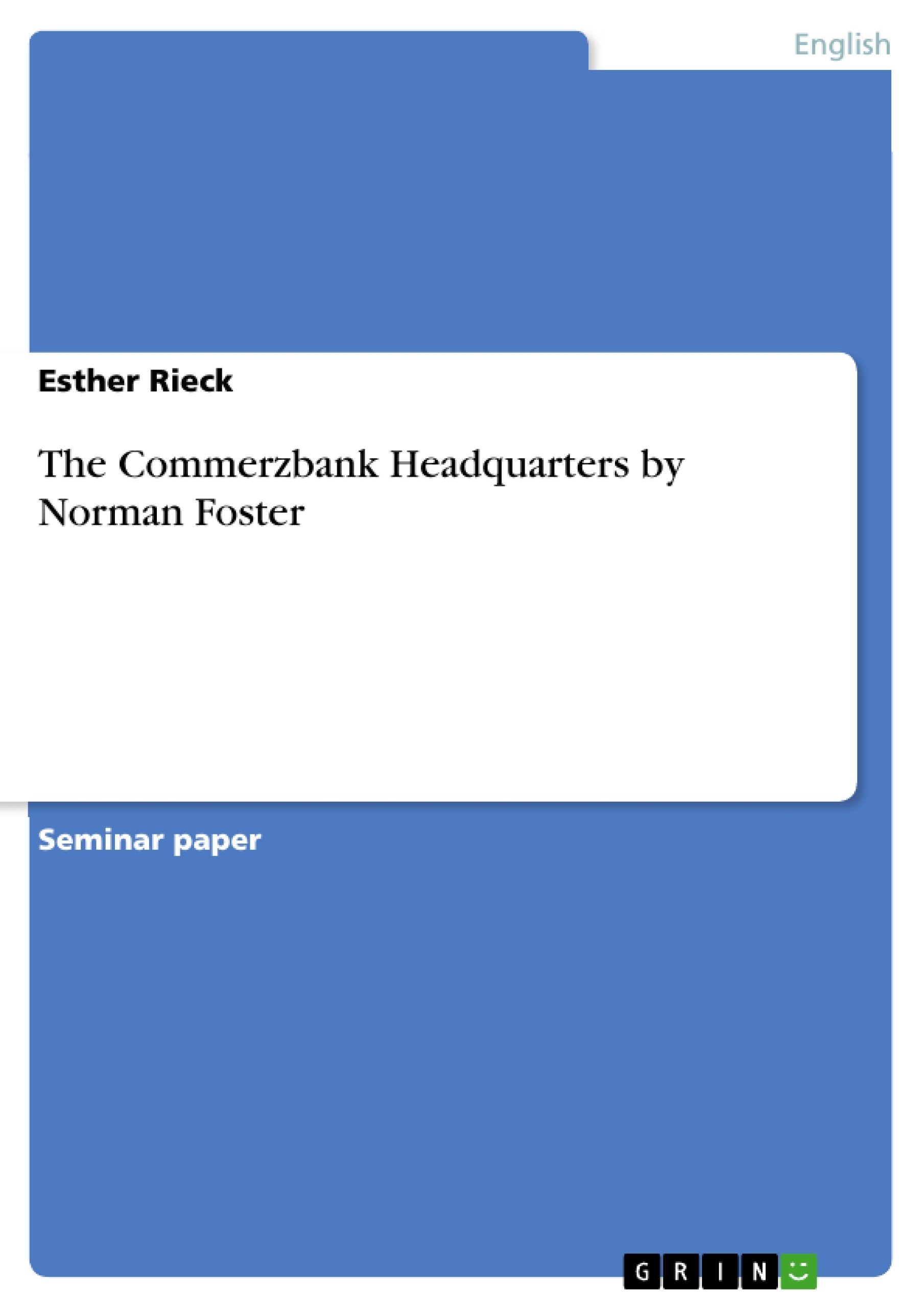Excerpt
Contents
1. Introduction
2. Structure
3. Cladding
4. Ventilation
5. Conclusion
6. Bibliography
1. Introduction
The subject matter of this term paper is a description as well as an interpretation of the “Commerzbank Headquarters” in Frankfurt which was built by Norman Foster. First I will say a few words about Norman Foster and his works and afterwards about the background of the Commerzbank. In the main part I want to concentrate on the Commerzbank in Frankfurt with its structure and how this “green” skyscraper works.
Norman Foster was born in Manchester in 1935. In 1961 after his final degree at the School of Architecture and City Planning at the University of Manchester, he was given a bursary of the University of Yale where he finished his studies with a master’s degree in architecture. In 1963 he formed the “Team 4”, together with his colleague and friend Richard Rogers. Four years later they split off and went separate ways. Foster founded “Foster Associates” which was later renamed in “Foster and Partners”. He was knighted in 1990 and appointed to the Order of Merit in 1997. In 1999 he was created a life peer. Foster has received more than 190 awards and citations for his projects and has won over 50 national and international competitions.
The Commerzbank Tower, at 300 meters tall, is one of the tallest buildings in Europe and the tallest naturally ventilated building in the world. The German political and social environment played a big role in the development of the design for this building. Frankfurt's "Green Party" strongly encouraged Commerzbank's new structure to be ,obviously, “green”. The aim was to create a revolutionary high rise, a high rise that would be both environmentally and people friendly. This building would also have to be a landmark for a town committed to building towers that symbolize hope for a future as a key European financial centre while providing space for about 2600 employees. In order to fulfil these requirements and still create green architecture, Norman Foster had to redesign the concept the skyscraper itself. Some of the ideas which were realized in Frankfurt had their roots in earlier works done by Foster. Back in 1971 he tried to integrate nature into an office building. “Willis Faber & Dumas” with its roof garden was his first building where he combined a garden with an office building. A few years later the “Hong Kong and Shanghai Bank” Headquarters was envisioned to have “gardens in the sky”, but this idea was never realized.[1]
2. The Structure
Essentially the Commerzbank tower is a hollow tube standing on one of its ends. The vertical loads are concentrated at the outer walls of the building with the intention that the structural footprint can be as large as possible.[2] This special shape is by law of nature very stable and is able to resist horizontal wind loads. But this tube had to be perforated by the large openings of the gardens and, of course, by the windows. The entire architectural concept is based on these four-storey-high openings which run from the façade to the central core of the building. Because of the spiral arrangement of the gardens, the construction remains constantly solid. To keep the gardens free from columns the vertical forces have to be moved to the corners of the triangular plan. For that reason the structure consists of two main elements, namely the corner columns and the eight-storey-high steel structures which span across the gardens.[3] These structures, which are bridge-like, have two main functions. On the one hand, they are able to hold the floors, and on the other hand, they can resist wind loads. Another solution that could have been able to grant these two functions would have been the form of deep trusses. But this option was rejected in favour of a Vierendeel frame of vertical and horizontal members which distributes the loads equally through the structure. It would have been possible to fabricate these Vierendeel frames of concrete, but they would have been too thick and only 40 per cent of the façade would have been free for glazing. That is why it was decided to make these frames from steel. Moreover, the steel construction has another big advantage; it is much lighter. Amazingly, it weighs about the same as the old Commerzbank tower (about 132000 tonnes). The weight of the building is a major factor with regard to the foundations. Because of the shape of the Commerzbank site the new tower had to be built right next to the old one.
Furthermore, Foster moved what usually constitutes the core of the building namely elevators, stairs, and lavatories to the corners of his triangular tower, thereby creating a hollow shaft.[4] This inner atrium runs the entire height of the building and allows fresh air and natural light to penetrate the building.
Foster has given every office impressive views, a chance to be near plants and breaks from the monotony of typical office tower life.
[...]
[1] Jenkins, David (editor), Norman Foster: Works 4 (Munich: Prestel Verlag, 2004), p.37
[2] Davies, Colin, Ian Lambot, Commerzbank Frankfurt (Haselmere, Surrey: Watermark, 1997), p. 63
[3] Davies, Colin, Ian Lambot, p. 63
[4] Foster, Norman, Martin Pawley, Norman Foster A global Architecture (London: Thames & Hudson, 2001), p. 171
- Quote paper
- Esther Rieck (Author), 2006, The Commerzbank Headquarters by Norman Foster, Munich, GRIN Verlag, https://www.grin.com/document/50766
Publish now - it's free






















Comments